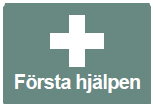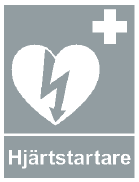Emergent illness or injury
- What has happened? Try to get a sense of the situation.
- Check if the site is safe before intervening.
- It is important to ensure that the same thing will not happen to you.
- Rescue those in danger.
- If necessary – provide first aid.
- Time – every second counts. Never hesitate – always call 112.

Find out where the first aid equipment is located!
Cardiopulmonary resuscitation (CPR)
Determine whether the person is conscious. If not:
- Call for help.
- No breathing or abnormal breathing – call 112 and start CPR with 30 chest compressions and then 2 breaths.
- Check for breathing, create an open airway by bending the head back and lifting the chin, listen and feel for breathing.
- Normal breathing – position the person in a stable lateral position.
- Begin CPR
- Defibrillators should be used as early/quickly as possible.
 There are three defibrillators on campus. They are located outside the Reception in Balder, on the entrance floor of the University Library in Sandgärdet and in U4 of the Textile Fashion Center.
There are three defibrillators on campus. They are located outside the Reception in Balder, on the entrance floor of the University Library in Sandgärdet and in U4 of the Textile Fashion Center.
Link to Sveriges hjärtstartarregister (Swedish only)
Myocardial infarction/heart attack (symptoms)
- Strong, pressing, or cramping pain in the chest that does not go away.
- Diffuse, but unpleasant feeling in the chest lasting more than 15 minutes.
- Chest pain combined with shortness of breath, cold sweats, or irregular heartbeat.
Stroke/brain haemorrhage (symptoms)
- Sudden weakness or numbness in the face, arms or legs, usually – but not always – only in one half of the body.
- Sudden difficulty in speaking or understanding, this can sometimes appear as confusion.
- Sudden double vision or visual disturbances in one or both eyes.
- Sudden difficulty walking, sudden dizziness, vertigo or loss of balance and coordination.
- Sudden, severe headache with no clear cause.
FAST test (stroke)
If a person cannot do the following, this could be a sign of a stroke:
- F for Face – can the person smile and show their teeth? Is one side of the mouth hanging down?
- A for Arms– can the person lift their arms and keep them up for 10 seconds?
- S for Speech – can the person repeat a simple sentence like "The weather is beautiful today"? Is the person slurring or struggling to find the right words?
- T for Time – every second counts. If the person has these symptoms, don’t hesitate. Call 112 immediately.
Allergic reaction
- If possible, remove the cause of the reaction.
- In case of general poor condition or respiratory problems, call 112.
- Ask about any medications and help the person to take them.
- Check the person’s breathing and create an open airway.
Asthma
- Help the person to get their medication and loosen tight clothing.
- Move the person away from the cause of the asthma attack, if possible.
- If the attack does not resolve, call an ambulance.
Diabetes
- If the diabetic person is conscious, give them something to eat or drink that contains sugar.
- Wait 10–15 minutes for reaction. If the food or drink does not help, the diabetic person has gone into insulin shock.
- Never give an unconscious person anything to eat or drink.
Epilepsi
 Prevent injuries to the person by, for example, putting something soft under their head.
Prevent injuries to the person by, for example, putting something soft under their head.- Don't put anything in their mouth as it can do more harm than good.
- Stay with the person until the seizure has ended.
- Many people with epilepsy often wear a symbol, such as a brooch or necklace, to inform people that they have epilepsy.
- Anyone who witnesses a suspected epileptic seizure should check whether the person has the epilepsy symbol before calling an ambulance. Usually the seizure ends in a few minutes.
In case of emergent danger to life, health and property, contact SOS Alarm 112.

